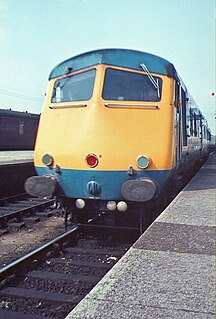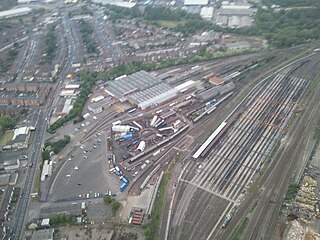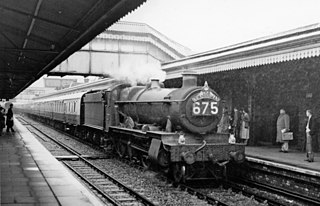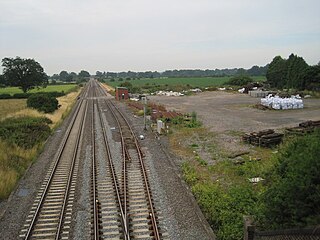
InterCity was introduced by British Rail in 1966 as a brand-name for its long-haul express passenger services.

The Blue Pullmans were luxury trains used from 1960 to 1973 by British Rail. They were the first Pullman diesel-electric multiple units, incorporating several novel features.
The Western Region was a region of British Railways from 1948. The region ceased to be an operating unit in its own right on completion of the "Organising for Quality" initiative on 6 April 1992. The Region consisted principally of ex-Great Western Railway lines, minus certain lines west of Birmingham, which were transferred to the London Midland Region in 1963 and with the addition of all former Southern Railway routes west of Exeter, which were subsequently rationalised.

The Chiltern Main Line is an inter-urban, regional and commuter railway, part of the British railway system. It links London (Marylebone) and Birmingham, the United Kingdom's two largest cities, by a 112-mile (180 km) route via High Wycombe, Banbury, and Leamington Spa.

Aston railway station serves the districts of Aston and Nechells in Birmingham, England. The passenger entrance is on Lichfield Road. The station is on the Cross-City Line and the Chase Line.

Walsall railway station is the principal railway station of Walsall, West Midlands, England and situated in the heart of the town. It is operated by West Midlands Trains, with services provided by West Midlands Railway and from 2019, London Northwestern Railway operate a service from Rugeley to London Euston that calls at the station. The main entrance is situated inside the Saddlers Shopping Centre.

Ivybridge railway station is situated on the Exeter to Plymouth line and serves the town of Ivybridge in Devon, England. It is 40 miles 35 chains (65.1 km) down the line from Exeter St Davids and 234 miles 27 chains (377.1 km) measured from London Paddington via Bristol Temple Meads.

The Shrewsbury and Birmingham Railway was authorised in 1846. It agreed to joint construction with others of the costly Wolverhampton to Birmingham section, the so-called Stour Valley Line. This work was dominated by the hostile London and North Western Railway, which used underhand and coercive tactics. The section between Shrewsbury and Wellington was also built jointly, in this case with the Shropshire Union Railway.

The Cambrian Coast Express was a named passenger train of the Great Western Railway (GWR), and later British Rail, running from London Paddington via Shrewsbury to Aberystwyth and Pwllheli over the Cambrian Line.

Wellington railway station serves the town of Wellington, Shropshire, England. It is situated on the former Great Western Railway's London Paddington to Birkenhead via Birmingham Snow Hill line. Trains are operated by West Midlands Railway, Avanti West Coast and Transport for Wales. At its peak, the station hosted six platforms, four through and two bay platforms (of which one survives, now known as platform 3, which has seen little use since the 2008 withdrawal of the Walsall local services..

Aberdovey railway station serves the seaside resort of Aberdyfi in Gwynedd, Wales. The station is on the Cambrian Coast Railway with passenger services every two hours calling at all stations between Machynlleth and Pwllheli, including Tywyn, Barmouth, Harlech and Porthmadog. Passengers can connect at Machynlleth for trains to Aberystwyth or Shrewsbury, Wolverhampton, Birmingham New Street and Birmingham International.

Witton railway station serves the Witton area of the city of Birmingham, England. It is situated on the Birmingham-Walsall Line, part of the former Grand Junction Railway, opened in 1837. The line through the station was electrified in 1966 as part of the London Midland Region's electrification programme. The actual energization of the line from Coventry to Walsall through Aston took place on 15 August 1966. The station, and all trains serving it, are operated by West Midlands Trains.

Hamstead railway station serves the Hamstead, Great Barr and Handsworth Wood areas of Birmingham, England. It is located at the junction of Rocky Lane and Old Walsall Road, Hamstead, at Birmingham's border with the borough of Sandwell. It is situated on the Birmingham-Walsall Line, part of the former Grand Junction Railway, opened in 1837. The station, and all trains serving it, are operated by West Midlands Trains.

Tyseley TMD is a railway Traction Maintenance Depot situated in Tyseley, Birmingham, England.

The Cornishman was a British express passenger train to Penzance in Cornwall. From its inception in the 19th century until before World War II it originated at London Paddington. Under British Railways it became a quite different service, starting variously from Wolverhampton, Derby, Sheffield, Leeds or Bradford.
The Worcester and Hereford Railway started the construction of a standard gauge railway between the two cities in 1858. It had needed the financial assistance of larger concerns, chiefly the Oxford, Worcester and Wolverhampton Railway, and the Newport, Abergavenny and Hereford Railway. It opened its line progressively from 1859 to 1861, delayed by exceptionally difficult tunnelling at Colwall and Ledbury. The company was purchased by the West Midland Railway in 1860, and that company amalgamated with the Great Western Railway in 1863.
The Birmingham, Wolverhampton and Dudley Railway was an English railway company promoted to connect those places by rail. It was authorised by Parliament in 1846. It became apparent that it would be advantageous to merge with the Great Western Railway. The rival London and North Western Railway went to great lengths to frustrate the amalgamation, but ultimately failed, and the merger took place in 1847.

The Cathedrals Express was a named passenger express introduced in 1957 on the Western Region of British Railways. It connected the cathedral cities of Hereford and Worcester to London Paddington.

Spetchley railway station was an intermediate stop on the Birmingham and Gloucester Railway, opened in 1840. Besides the village of Spetchley, it served the city of Worcester until 1850. It closed to passengers in 1855 but remained open for goods until 1961.

The Birmingham Pullman was a named passenger train operating in the United Kingdom.

















